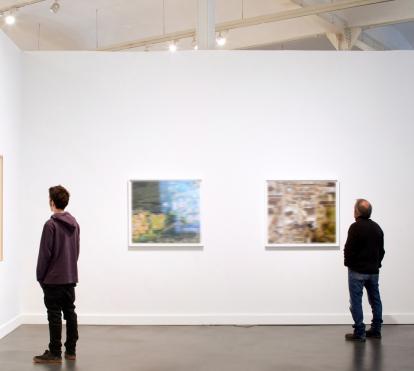
"Pre-Raphaelitism has but one principle, that of absolute, uncompromising truth in all that it does, obtained by working everything, down to the most minute detail, from nature and from nature only. Every Pre-Raphaelite landscape background is painted to the last touch, in the open air, from the thing itself. Every minute accessory is painted in the same manner". With these words, John Ruskin (1819-1900), painter, writer, collector and, as a critic, one of the most influential voices of his time, accurately defined the principles that marked the Pre-Raphaelite landscape. Pre-Raphaelites: The Vision of Nature is the first exhibition that centres exclusively on the profound fascination the Pre-Raphaelites felt for the natural world, and on how, through their interpretation of nature, they set certain standards that marked 20th century art.The show gathers some 150 works, including such renowned pictures as Ophelia (1851-52) by John Everett Millais, Our English Coasts (Strayed Sheep) (1852) by William Holman Hunt, and The Pretty Baa-Lambs (1851-59) by Ford Madox Brown. The paintings belong to the leading British galleries, such as the Tate Britain, the British Museum, the Victoria and Albert Museum and the Birmingham Museum and Art Gallery.The exhibition has been curated by Allen Staley and Christopher Newall, in collaboration with Alison Smith, Ian Warell and Tim Batchelor, curators of the Tate Britain in London. Open to the public from 29 September 2004 to 9 January 2005 at the Exhibition Hall of ”la Caixa” Foundation in Madrid (Calle Serrano, 60), the show has been organised by the Tate Britain in conjunction with ”la Caixa” Foundation and the Alte Nationalgalerie of Berlin. The Pre-Raphaelite movement vastly transformed the English conception of landscape painting in the 1850s and continued to influence this discipline even long after. The Pre-Raphaelite group's decision to paint out of doors and to work directly from nature led to new pictorial forms, the achievements of which, it could be said, were as revolutionary as those of the French Impressionists. The painters William Holman Hunt (1827-1910), Dante Gabriel Rossetti (1821-1882) and John Everett Millais (1829-1896) founded the Pre-Raphaelite Brotherhood in London, 1848. Originally it was made up of seven young artists. The three aforementioned ones were joined by the art critics William Michael Rossetti (1829-1919) and Frederic George Stephens (1828-1907), the painter James Collinson (1825-1881), and the sculptor Thomas Woolner (1825-1892). They chose the name Pre-Raphaelite Brotherhood to express their rejection of all art subsequent to that of Raphael, and inspired their work on an archaic pictorial past, which they considered to be closer to nature. Pre-Raphaelitism came into being as a hostile reaction to the Realist movement, with the purpose of formulating a moral and intellectual protest against academic oppression. At the beginning, the Pre-Raphaelite painters sought to establish a national art based on the almost scientific reproduction of nature by working outdoors, thus providing the spectator with a multi-sensory experience of nature through painting. Not without contradictions, they yearned for a return to the mediaeval aesthetic. Yet at a later stage, fascinated and at the same time concerned by technological progress and the rising new industrial civilisation, they began to turn in their works to subjects of a social nature. Pre-Raphaelites: The Vision of Nature is divided into six sections. The first, Rejecting Nothing, Selecting Nothing addresses the Pre-Raphaelite painters' fascination for minute detail and its representation. Within this context, reference is also made to the appeal of photography to the Pre-Raphaelites, a medium that faithfully represented reality and which was beginning to be used towards artistic ends. The Mere Look of Things looks at the concern for the ordinary and the mundane, which led certain artists to represent city outskirts, as Ford Madox Brown's An English Autumn Afternoon (1852-55) clearly exemplifies. Holy Lands explores a new type of landscape painting that emerged as a result of the growing fascination with the East and places with Biblical echoes, as well as a wish to accurately document, through immensely detailed paintings, sites and edifices believed to be in danger of disappearing. This section includes works like The Sphinx, Gizeh, Looking towards the Pyramids of Sakhara by William Holman Hunt. Understanding the Landscape dwells on the interest shown by these painters in geology. Works like John Brett's The Glacier of Rosenlaui (1856) reflect the impact on art of the scientific research of the period into mountain erosion and glacier movement. In contrast, the section The Inhabited Landscape does not treat the landscape as the creation of nature or God, but rather as conceived increasingly more frequently as the scenario of human activities in pre-industrial rural Great Britain. Another outstanding work in this section is William Dyce's Pegwell Bay (1860). The closing section, Impression of the Effect, enables the spectator to observe the abandoning of intricate detail in favour of a more poetic type of landscape, as can be seen in John Brett's monumental picture The British Channel Seen from the Dorsetshire Cliffs (1871), one of the revelations of the exhibition.The exhibition Pre-Raphaelites: The Vision of Nature has been curated by Allen Staley, professor emeritus of Art History at Columbia University and by Christopher Newall, writer, art historian and specialist in 19th-century British art, in collaboration with Alison Smith, senior programme curator of the Tate Britain and specialist in 19th-century British art; Ian Warrell, curator of the Tate Gallery and specialist in 19th-century British photography and art; and Tim Batchelor, assistant curator of the Tate Britain.Pre-Raphaelites: The Vision of NatureFrom 29 September 2004 to 9 January 2005 Opening: Tuesday 28 September 2004, at 8:00 p.m.Exhibition Hall of ”la Caixa” Foundation Calle Serrano, 60 (Madrid)Telephone: 902 22 30 40Opening Hours: Mondays to Saturdays, 11:00 a.m. 8:00 p.m. Sundays and holidays, 11:00 a.m. 2:30 p.m. Closed Tuesdays.Admission free of charge www.fundacio.lacaixa.es